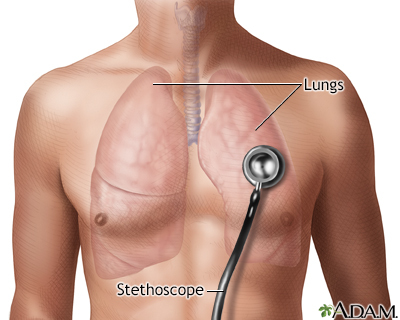Breath sounds
Definition
Breath sounds are the noises produced by the structures of the lungs during breathing.

Alternative Names
Lung sounds; Breathing sounds
Considerations
The lung sounds are best heard with a stethoscope. This is called auscultation.
Normal lung sounds occur in all parts of the chest area, including above the collarbones and at the bottom of the rib cage.

Using a stethoscope, the health care provider may hear normal breathing sounds, decreased or absent breath sounds, and abnormal breath sounds.
Absent or decreased sounds can mean:
- Air or fluid in or around the lungs (such as pneumonia, heart failure, and pleural effusion)
- Increased thickness of the chest wall
- Over-inflation of a part of the lungs (emphysema can cause this)
- Reduced airflow to part of the lungs
There are several types of abnormal breath sounds. The four most common are:
- Rales. Small clicking, bubbling, or rattling sounds in the lungs. They are heard when a person breathes in (inhales). They are believed to occur when air opens closed air spaces. Rales can be further described as moist, dry, fine, and course.
- Rhonchi. Sounds that resemble snoring. They occur when air is blocked or air flow becomes rough through the large airways.
- Stridor. Wheeze-like sound heard when a person breathes. Usually it is due to a blockage of airflow in the windpipe (trachea) or in the back of the throat.
- Wheezing. High-pitched sounds produced by narrowed airways. They are most often heard when a person breathes out (exhales). Wheezing and other abnormal sounds can sometimes be heard without a stethoscope.
Patient Education Video: What causes wheezing?
Causes
Causes of abnormal breath sounds may include:
- Acute bronchitis
- Asthma
- Bronchiectasis
- Chronic bronchitis
- Congestive heart failure
- Emphysema
- Interstitial lung disease
- Foreign body obstruction of the airway
- Pneumonia
- Pulmonary edema
- Tracheobronchitis
When to Contact a Medical Professional
Seek immediate medical care if you have:
- Cyanosis (bluish discoloration of the skin)
- Nasal flaring
- Severe trouble breathing or shortness of breath
Contact your provider if you have wheezing or other abnormal breathing sounds.
Your provider will do a physical exam and ask you questions about your medical history and your breathing.
Questions may include:
- When did the breath sound start?
- How long did it last?
- How would you describe your breathing?
- What makes it better or worse?
- What other symptoms do you have?
The provider usually discovers abnormal breath sounds. You may not even notice them.
The following tests may be done:
- Analysis of a sputum sample (sputum culture, sputum Gram stain)
- Blood tests (including an arterial blood gas)
- Chest x-ray
- CT scan of the chest
- Pulmonary function tests
- Pulse oximetry
Gallery


References
Ball JW, Dains JE, Flynn JA, Solomon BS, Stewart RW. Chest and lungs. In: Ball JW, Dains JE, Flynn JA, Solomon BS, Stewart RW, eds. Siedel's Guide to Physical Examination. 9th ed. St Louis, MO: Elsevier; 2019:chap 14.
Kraft M. Approach to the patient with respiratory disease. In: Goldman L, Schafer AI, eds. Goldman-Cecil Medicine. 26th ed. Philadelphia, PA: Elsevier ; 2020:chap 77.